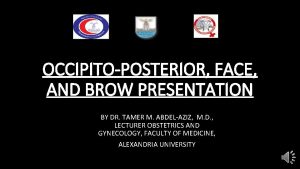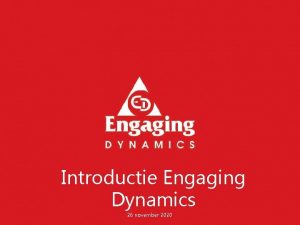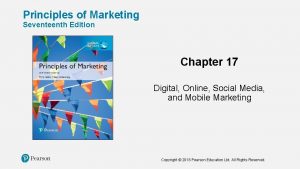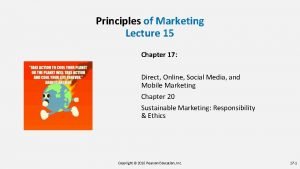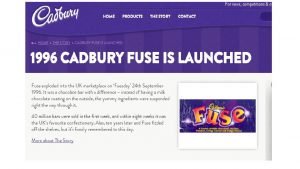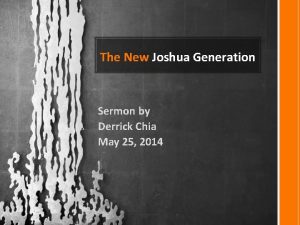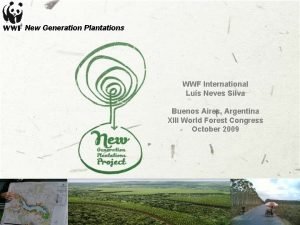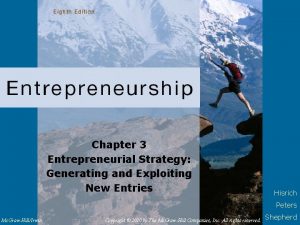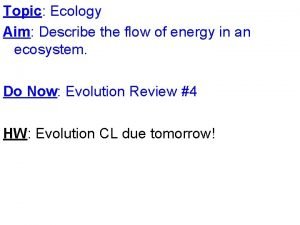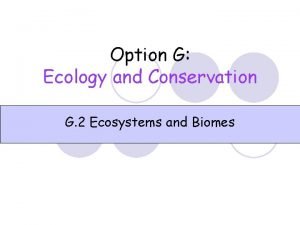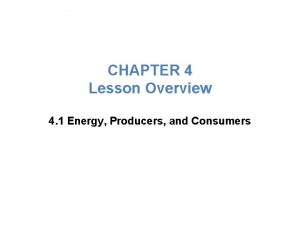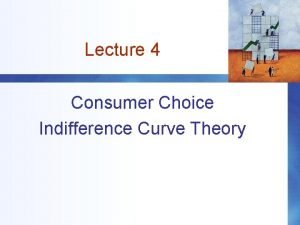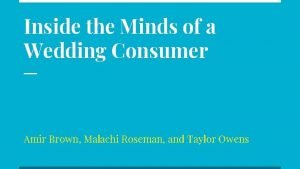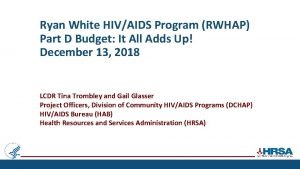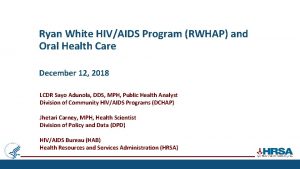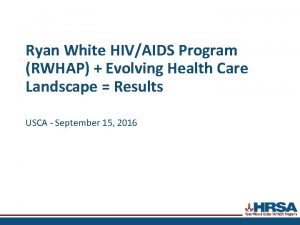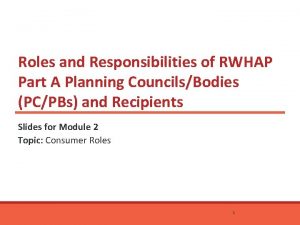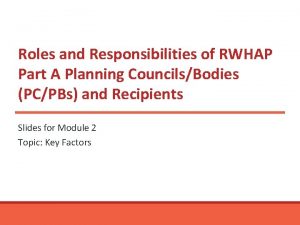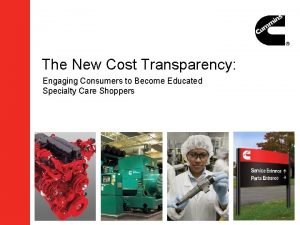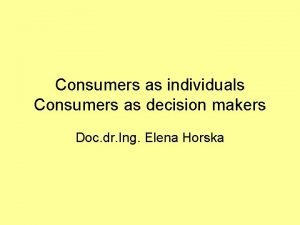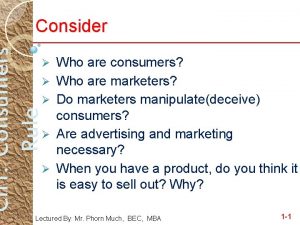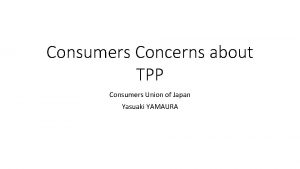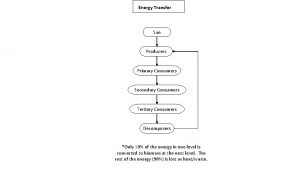Engaging a New Generation of Consumers in RWHAP













![Planning Council/Planning Body Diversity: HRSA/HAB Reflectiveness Chart Living with HIV/AIDS in EMA/TGA [Race/Ethnicity] [Gender] Planning Council/Planning Body Diversity: HRSA/HAB Reflectiveness Chart Living with HIV/AIDS in EMA/TGA [Race/Ethnicity] [Gender]](https://slidetodoc.com/presentation_image_h2/e756d92e62ec8459566d423771177814/image-14.jpg)



































- Slides: 49


Engaging a New Generation of Consumers in RWHAP Planning: Innovations That Work Cecilia Ross Oshingbade, Chair, Houston EMA Ryan White Planning Council Brandi C. Bowen, Program Director, New Orleans Regional AIDS Planning Council Hila Berl, Vice President, EGM Consulting, LLC

This workshop was developed as part of the Community HIV/AIDS Technical Assistance and Training (Planning CHATT) Project

Poll #1: Your RWHAP Part Please use your clicker to indicate which Ryan White HIV/AIDS Program (RWHAP) Part or Parts you are associated with – Click on all that apply: 1. Part A – Eligible Metropolitan Area (EMA) 2. Part A – Transitional Grant Area (TGA) 3. Part B 4. Part C 5. Part D 6. Part F 7. None

Poll #2: Your Affiliation Please specify your most important relationship(s) with RWHAP community planning. Click on up to 2 responses. 1. 2. 3. 4. 5. 6. 7. PC/PB member Planning council/planning body staff (PCS) RWHAP recipient RWHAP subrecipient/service provider HIV/AIDS Bureau staff Other N/A (not involved with any RWHAP program)

Workshop Purposes • • Discuss challenges for RWHAP planning councils/planning bodies (PC/PBs) and Consumer Advisory Boards (CABs) in maintaining active participation by consumers, especially young people and those recently diagnosed Explore innovative practices for engaging a new generation of consumers and other people living with HIV (PLWH) as: § § Planning Council/Planning Body (PC/PB) members Members of committees, including the Consumer Committee Consumer Advisory Board (CAB) members Regular sources of input and advice • Identify strategies to use back home to engage a new generation of consumers and other PLWH in RWHAP planning

Learning Outcomes 1. To identify 3 challenges your planning body has faced in engaging consumers, especially those who are under 35 or recently diagnosed 2. To describe at least 3 approaches for engaging a “new generation” of consumers and keeping them involved 3. To identify at least 1 strategy for back-home use in engaging consumers in the RWHAP planning process

Poll #3: Length of Involvement with RWHAP Planning How long have you been involved with a RWHAP planning council/planning body or other aspects of HIV community planning? Click on 1 response. 1. 2. 3. 4. 5. 6. Less than 2 years 2 -5 years 6 -10 years 11 -15 years More than 15 years N/A

RWHAP Part A Legislative Requirement for Consumer Membership “Not less than 33 percent of the council shall be individuals who are: • receiving HIV-related services pursuant to a [Part A grant], • are not officers, employees, or consultants to any entity that receives [Part A funding], and do not represent any such entity, and • reflect the demographics of the population of individuals with HIV/AIDS” [Legislation, § 2602(b)(5)(C)]

Poll #4: Level of Consumer Involvement What is the level of involvement of unaligned RWHAP consumers (no conflict of interest) in your planning council/planning body? Click on 1 response. 1. 2. 3. 4. 5. More than 33% of voting members At least 33% of voting members Some voting members but less than 33% No unaligned consumers as voting members N/A – not associated with a planning council/planning body

Legislative Requirements for “Reflective” PC/PB Membership • For RWHAP Part A Planning Councils: • “…the chief elected official…shall establish or designate an HIV health services planning council that shall reflect in its composition the demographics of the population of individuals with HIV/AIDS in the eligible area involved, with particular consideration given to disproportionately affected and historically underserved groups and subpopulations” [§ 2602(b)(1)] • For other RWHAP planning bodies: Membership reflectiveness is strongly encouraged but not legislatively required

HRSA/HAB Expectations for Part A PC/PBs • PC/PBs expected to meet Part A reflectiveness requirements for both: § § Full membership Consumer membership • “Reflectiveness must be based on the prevalence of HIV Disease (AIDS Prevalence plus HIV Prevalence, real or estimated) in your EMA/TGA as reported in your FY 2018 application and Legislation” • “…the grant recipient must be able to demonstrate that the PC/PB is reflective of any disproportionately affected or historically underserved populations in the jurisdiction (ex: if MSM make up 60% of the jurisdictions infected population, the recipient must be able to demonstrate that this population is appropriately reflected in the PC/PB membership)” [FY 18 Part A Planning Council/Planning Body Reflectiveness and Roster, submitted as part of the Part A Program Terms Report and Program Submission]

HRSA/HAB-Required Reflectiveness • Components of reflectiveness: § Race/ethnicity § Gender § Age • For each component, Reflectiveness Chart submitted to HRSA/HAB asks for numbers and percentages to compare: § Persons living with HIV in the EMA or TGA § Total members of the PC/PB § Non-aligned consumer members of the PC/PB
![Planning CouncilPlanning Body Diversity HRSAHAB Reflectiveness Chart Living with HIVAIDS in EMATGA RaceEthnicity Gender Planning Council/Planning Body Diversity: HRSA/HAB Reflectiveness Chart Living with HIV/AIDS in EMA/TGA [Race/Ethnicity] [Gender]](https://slidetodoc.com/presentation_image_h2/e756d92e62ec8459566d423771177814/image-14.jpg)
Planning Council/Planning Body Diversity: HRSA/HAB Reflectiveness Chart Living with HIV/AIDS in EMA/TGA [Race/Ethnicity] [Gender] Age 13 -19 years 20 -29 years 30 -39 years 40 -49 years 50 -59 years 60+ years Total Number Percentage Total Members of the PC/PB Number Percentage Non-Aligned Consumers on the PC/PB Number Percentage

Expectations for Consumer Advisory Boards (CABs) • Universal National Monitoring Standards call for “structured and ongoing efforts to obtain input from clients in the design and delivery of services, ” including through subrecipient Consumer Advisory Boards (CABs) [NMS, Universal Standards, Section A: Access to Care] • Part C recipients that are federally qualified health centers (FQHCs) typically operate CABs – and a majority of their Boards are clinic patients • Like PC/PBs, CABs are most useful when diverse in terms of age, race/ethnicity, gender, and other factors

Importance of Engaging a New Generation of Consumers in RWHAP Planning • Community and consumer engagement is the foundation of the RWHAP planning process • RWHAP planning councils and planning bodies play a major role in shaping local and state systems of HIV care and treatment • HIV community planning is based on inclusiveness and diversity – people with differing characteristics, affiliations, and backgrounds coming together • Diverse perspectives help ensure the availability of services appropriate for diverse groups of PLWH

Why Youth? To Address HIV Health Disparities • Nationally, in 2016, young people aged 13 -24 made up 21% of new HIV diagnoses • HIV incidence rate was 12. 3 per 100, 000 for all age groups but: § 34. 8 for young adults aged 25 -29 – the highest rate for any age group § 30. 3 for young adults aged 20 -24 • An estimated 51% of youth 13 -24 with HIV were unaware of their status – the highest rate in any age group • As of 2014, among youth with HIV aged 13 -24: § 41% were receiving HIV medical care § 31% were retained in HIV care § 27% had a suppressed viral load – the lowest rate for any age group

Data on Youth/Young Adults as RWHAP Clients, 2016 • Almost 22% of RWHAP clients are aged 13 -34 § 4. 6% are 13 -24 § 17% are 25 -34 • Young PLWH have the lowest levels of viral suppression among any age group of RWHAP clients (see chart) § Viral suppression is lowest among transgender youth aged 1324: 63. 4% [Clients Served by the Ryan White HIV/AIDS Program, 2016]

Viral Suppression among Clients Served by RWHAP by Age Group, 2016 - U. S. and 3 Territories 93, 9% 90, 6% (Percent) 87, 1% 84, 9% 84, 7% 82, 9% <13 71, 1% 77, 6% 13 -24 25 -34 35 -44 45 -54 55 -65 65+ All Viral suppression: ≥ 1 OAHS visit during the calendar year and ≥ 1 viral load reported, with the last viral load result <200 copies/m. L. Source: HRSA, Clients Served by the Ryan White HIV/AIDS Program, 2016, HIV Care Outcomes: Viral Suppression. Territories included are Guam, Puerto Rico, and the U. S. Virgin Islands

Poll #5: Young Members How many members of your planning council/planning body are under the age of 35? 1. 2. 3. 4. 5. 6. None 1 2 -3 More than 3 Don’t know N/A – not associated with a planning council/planning body

Challenges in Engaging a New Generation of Consumers in RWHAP Planning Cecilia Ross Oshingbade Chair, Houston EMA Ryan White Planning Council

Poll #6: Who is Part of the “New Generation of Consumers”? From the perspective of your planning council/ planning body or program, what qualifies a person to be considered part of a “new generation of consumers”? Click on all that apply. 1. 2. 3. 4. 5. Age under 25 Age under 35 Member of a disproportionately affected population Person diagnosed with HIV within the past 3 years Other

Discussion: Are the Following Individuals Part of Your “New Generation of Consumers”? Why/Why Not? 1. A woman diagnosed with HIV 6 months ago at the age of 51 2. A young man age 24 who was born with HIV, told about his medical condition at age 7, is taking medications, and has an undetectable viral load 3. A young adult age 20 who was born with HIV, never told of his status but given medications, discovered his status two months ago, and has an undetectable viral load 4. A newly diagnosed woman age 66, a widow who was infected by her boyfriend

Identifying Challenges in Engaging Consumers – Especially Those under 35 or Recently Diagnosed

PC/PB Membership Challenges • Most PC/PBs report challenges in maintaining active participation by consumers and other PLWH • PC/PB membership tends to include primarily: § Individuals in their late 40 s, 50 s, and 60 s § Consumers that are long-term survivors • Most PC/PBs and many Consumer Committees report little involvement by PLWH who are under 35 or diagnosed with HIV in the past 5 years

Identified Barriers to Consumer/PLWH Engagement • Assumed limitations on consumer capacity for sound decision making in an increasingly complex HIV prevention and care environment • Perception that other members hold most power & influence • Negative environment – tension and conflict • Stigma and disclosure issues • Hiring of unaligned consumers – constant need to recruit [PC/PB Assessment Conducted for HRSA/HAB by EGM Consulting, LLC, 2016]

Additional Identified Barriers Transportation and other expenses Personal and societal challenges (e. g. , health, co-morbidities) Language & cultural differences – including lack of interpreters Exclusion of consumers from some official boards/commissions due to past legal problems • Insufficient orientation, training, and support • • [PC/PB Assessment Conducted for HRSA/HAB by EGM Consulting, LLC, 2016]

Special Challenges Faced by Young PC/PB Members • • • Hard to be the “only one” – only person of color under 30, only young MSM Generational issues: perceived dominance by long-time survivors § PC/PB felt “stagnant” § § • • “I was not taken seriously because I was the youngest, newest member” Some members were OK with continuing to do what they’ve been doing for a long time Others interested in change but wanted someone else to lead the process Didn’t understand unstated issues and relationships Pushed to take a leadership role without time to gain the needed knowledge [Subject Matter Expert Panel with Young Adult PLWH, EGMC for JSI Planning CHATT, June 26, 2018]

Recruitment and Retention Barriers and Errors • Focus on recruiting overcommitted young adults – already on other committees or advisory boards and have no more time • Lengthy, complex vetting process – and often a long delay before decision and appointment • Inflexible bylaws and policies § § In-person attendance required at meetings Processes that make meetings move slowly • Meeting times and locations that don’t work for students or people not employed in HIV or public health • Lack of targeted recruitment – PC/PB does not promote itself to young people [SME Panel]

Policies and Procedures that Discourage Youth and Young Adult Participation • PC/PB Bylaws and policies that do NOT include: § A requirement for a Co-Chair or other officer to be a consumer § A requirement or preference for targeting young consumers as committee members § Age identified as a factor in recruitment of consumers or other members • Consumer Committee polices and practices such as: § § § Emphasis on “experience” as measured by number of years members have been living with HIV – no focus on newly diagnosed or younger members Limited attention to issues faced by younger consumers such as employment, need for evening/weekend service hours Lack of outreach to newly diagnosed or young consumers

Houston Strategies: A Recruitment Pipeline For all consumers: • Project LEAP (Learning, Empowerment, Advocacy, Participation) § A comprehensive advocacy training program for HIV-positive individuals § Trains PLWH for active participation on an HIV planning body such as the RWHAP Part A planning council (PC) or HIV Prevention Planning Group (PPG) • External membership – voting committee member and non-voting PC member • Participation in a PC work group For young consumers: • Road 2 Success Youth Summit • Pairing of young consumers with trained mentors

Houston’s Road 2 Success/Camino hacia tu Salud • Operates under Affected Community Committee • Hosts 2 - and 4 -hour meetings in partnership with other consumer groups § Sessions held at location where the partner typically hosts meetings with consumers § Some sessions with existing groups, some advertised to the general HIV community § Some sessions in Spanish

Road 2 Success Youth Summits • Planning council has held 3 Transition Summits for youth transitioning from pediatric to adult care § Designed to address low rates of retention and viral suppression related to the transition § Addresses structural, clinical, and individual transition barriers • Summits include youth 15 -25 as well as their caregivers • Participants sometimes say they would like to share their experiences and become more involved • Sessions increase planning council visibility among youth and young adult consumers and can make contacts that lead to engagement with the planning council

Houston’s Current Participation of Young Adult Consumers LEAP Graduate PC Member Male age 29 Female age 28 Male age 31 Male age 39 Individual External Member All 4 current PC and External members began their involvement with the PC through the LEAP Program

Strategies in Engaging a New Generation of Consumers in RWHAP Planning Brandi C. Bowen, Program Director, New Orleans Regional AIDS Planning Council

Poll #7: Strategies to Help Recruit a New Generation of Members Which of the following strategies can assist you in recruiting a new generation of membership? (Check all that apply) 1. 2. 3. 4. 5. 6. Creating new partnerships and collaborations Supporting fresh leadership with training and mentorship Following HRSA Guidance Silencing dissenting voices Continuing to use the same protocols that are currently in place Revising Bylaws

Strategies to Engage the “New Generation” • Many of the strategies that work with other consumers work with young consumers and newly diagnosed PLWH • Some special/added awareness and strategies also needed • Recruitment should go beyond consumers: § The PC/PB as a whole needs young adult members to meet reflectiveness requirements § Can include young adults who are providers or non-consumer PLWH § A PC/PB with other young adult members may be seen as youthfriendly by potential consumer members

Factors Supporting Overall Consumer Engagement • Demonstrated respect for consumers – including young consumers – and their contributions • Inclusion as full partners in decision making, not just a source of input – “Nothing about us without us” • Recognition and appreciation by the PC/PB, its staff, and recipient • Clearly defined roles, responsibilities, and expectations • Meaningful work in committees – including consumer committee • Productive meetings that provide a sense of accomplishment • Convenient meeting times and locations [PC/PB Assessment Conducted for HRSA/HAB by EGM Consulting, LLC, 2016]

Other Strategies of Special Importance • Adequate PC staffing and support § “Staffing limitations dictate the amount of training and technical assistance provided” • Orientation, training, and opportunities for leadership – including pre -membership training • Flexibility • Open discussion about disparities in service access, quality, appropriateness, and outcomes and implications of race/ethnicity, age, class, and other factors PC/PB Assessment Conducted for HRSA/HAB by EGM Consulting, LLC, 2016

Young Adult Members: How They Found Out about the PC/PB • None found through the open nominations process • Found out about the PC/PB from: § Case manager, who provided a flier about a training program for potential members (LEAP) § Personal mentor, the Executive Director of a provider where he worked § Website: was looking for a way to contribute, found the PC/PB website, and saw that he knew one of the Co-Chairs § Co-workers were making a presentation to the PC/PB and he went with them to the meeting [SME Panel]

Young Adult Members: Why They Joined • • Feeling isolated at work – needed another way to contribute As a PLWH, wanted to know about how funds were being used Wanted to learn about advocacy Came by chance, and found members who were “very passionate” and caring

Young Adult Members: Why They Stayed • • Saw that the voices of young people of color need to be heard Sense of responsibility – “crucial for the PC/PB to be representative of the people affected” by HIV Duty to use this opportunity to empower other people Personal growth – “really thinking about accountability and accessibility” Realized there was a lot to be learned Felt supported by members when uncertain about continuing Mentorship by other members and PC/PB support staff PC/PB wanted new ideas [SME Panel]

Lessons from New Orleans: Innovations in the Planning Structure Young Men of Color Community Advisory Board • Builds on experience of developing and implementing Community Advisory Boards (CABs) • Compared to PC/PBS: § Different planning approach § Less stringent policies and protocols • Lessons learned from CAB members • Now incorporating CAB lessons into RWHAP planning • Future of CAB and impact on PC member recruitment

Factors for Successful Recruitment of Young Adults • Team effort required • Engagement of staff and interns – recruiting a younger workforce helps in recruiting a younger planning council • Focused retention efforts for a new generation • Convenience of participation – geographic and scheduling considerations • Respect, support, and realistic expectations • Use of modern technology • Training and mentorship – adjusted for a new generation • Forward thinking and a culture of openness to new ideas

Discussion What other factors should PC/PBs consider and address in order to successfully engage and retain a new generation of planners?

Seven Strategies to Consider 1. Determine how many more young consumers and other young members you need for PC/PB reflectiveness – then set goals 2. Prioritize recruitment of younger members including consumers as part of your next nominations process 3. Find partner entities that work with youth and young adults with HIV 4. Review Bylaws and policies with youth/young adult consumers to identify changes to make your PC/PB more younger-generation friendly 5. Provide an awareness session on engaging youth and young adults as part of a PC/PB meeting 6. Identify, implement, and publicize 3 changes to support young members 7. Establish a pipeline for young adult consumers

Poll #8: Needed Support Whose support is necessary to assist you in recruiting a new generation of membership? 1. 2. 3. 4. 5. 6. 7. 8. Chief Elected Official (CEO) Membership Committee PC/PB Support Staff General Membership Recipient Service Providers Other All of the above

Sum Up • RWHAP PC/PBs need “reflective” membership – among them a New Generation of consumers that includes young adults and recently diagnosed PLWH • Many of the same factors useful in engaging other consumers and PLWH will work with young adult consumers – but there also special issues • The best way to understand barriers and incentives for participation is to discuss them with young adult consumers • Making your PC/PB young adult-friendly takes time and requires direct efforts • Fully engaging a New Generation of consumers can add energy and new ideas that will contribute to improved services

Thank You! • Cecilia Ross Oshingbade: cysmith 2003@yahoo. com • Brandi Bowen: brandi@norapc. org • Hila Berl: hila@egmc-dc. com Planning CHATT: email: planning. CHATT@jsi. com website: https: //www. targethiv. org/planning-chatt Special thanks to Emily Gantz Mc. Kay, without whom this session would not have happened!
 Food web and food chain difference
Food web and food chain difference Producers primary consumers secondary consumers
Producers primary consumers secondary consumers Presenting diameter in occipito posterior
Presenting diameter in occipito posterior Engaging dynamics
Engaging dynamics Marketing involve engaging directly with carefully targeted
Marketing involve engaging directly with carefully targeted Marketing involve engaging directly with carefully targeted
Marketing involve engaging directly with carefully targeted First gen antipsychotics
First gen antipsychotics Lord you are good and your mercy
Lord you are good and your mercy Product idea development
Product idea development Generation of new entry opportunity in entrepreneurship
Generation of new entry opportunity in entrepreneurship Teachers the new generation will be your devotion
Teachers the new generation will be your devotion Derrick chia
Derrick chia Wwf new generation
Wwf new generation Metcardio
Metcardio Generation new millenium
Generation new millenium Strategy
Strategy Punctuating split speech
Punctuating split speech New york pennsylvania new jersey delaware
New york pennsylvania new jersey delaware Fresh oil, new wine scripture
Fresh oil, new wine scripture Marquee cinemas - orchard 10
Marquee cinemas - orchard 10 Characteristics of the articles of confederation
Characteristics of the articles of confederation New-old approach to creating new ventures
New-old approach to creating new ventures Marketing management
Marketing management New years old is new again
New years old is new again New classical and new keynesian macroeconomics
New classical and new keynesian macroeconomics Chapter 16 toward a new heaven and a new earth
Chapter 16 toward a new heaven and a new earth Leanne keene french ambassador arrives from paris
Leanne keene french ambassador arrives from paris New classical and new keynesian macroeconomics
New classical and new keynesian macroeconomics Roosevelt wilson and taft venn diagram
Roosevelt wilson and taft venn diagram What are producers
What are producers Tundra food chain
Tundra food chain Symbiotic relationships in the tropical rainforest
Symbiotic relationships in the tropical rainforest Tropical rainforest food web
Tropical rainforest food web Bear primary consumer
Bear primary consumer Energy pyramid deciduous forest
Energy pyramid deciduous forest Is a cockroach a producer consumer or decomposer
Is a cockroach a producer consumer or decomposer Producers consumers and decomposers
Producers consumers and decomposers Cycle of producers consumers and decomposers
Cycle of producers consumers and decomposers Horney's cad theory of personality
Horney's cad theory of personality Net production of consumers equation
Net production of consumers equation Ap gov scotus comparison frq example
Ap gov scotus comparison frq example Positioning involves meeting consumers lower performance
Positioning involves meeting consumers lower performance Decomposers in the coral reef
Decomposers in the coral reef Chapter 4 lesson 1 energy, producers and consumers
Chapter 4 lesson 1 energy, producers and consumers Consumers indifference map for sneakers and jackets
Consumers indifference map for sneakers and jackets Brides magazine targets consumers who are in
Brides magazine targets consumers who are in Detritivore vs decomposer
Detritivore vs decomposer Webswhat
Webswhat Food chains with 6 organisms
Food chains with 6 organisms Food chain with decomposers consumers and producers
Food chain with decomposers consumers and producers


